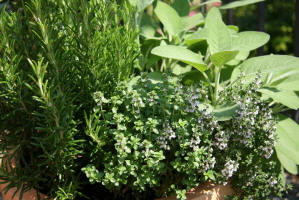|
Your online resource for all things culinary |
|
|||||||||
|
||||||||||
|
||||||||||
| Â | ||||||||||
|
||||||||||
|
Â
Fish and Seafood� basil, tarragon, basil, parsley, thyme, bay
leaves, coriander  Pasta and Pizza - Basil, borage, oregano, parsley, marjoram, thyme  Vegetables - Chives, coriander, dill, borage, sage, basil, oregano, marjoram, mint  Don't forget the myriad of herb butters and sauces which can add interest to many plainly cooked ingredients.  Growing your own herbs Many herbs are relatively easy to grow. Even if you don't have a garden, most can be grown in pots or containers both indoors on a window ledge or outdoors on the terrace, balcony or patio. This is also a great opportunity to learn how to build a raised bed garden if you are starting from scratch.   For specific details on growing a variety of herbs, visit our Growing Herbs page. Not only does it contain sowing and growing details, we also list the height and spread of the plants so you can incorporate them into your flower garden.  Of course, you can always go out and buy mature plants from the garden centre although this is a more expensive way of growing your own. Also, beware of buying herb plants from supermarkets except for the short term - they are generally grown for indoor use and often don't last very long, if at all, when placed in the garden.  Drying herbs - How to dry herbs Pick herbs for drying just before the plants flower preferably in the early morning but after any dew has evaporated. Avoid bruising the leaves.  Air Drying This is a traditional method of drying herbs and is suitable for the more sturdy herbs such as thyme, rosemary, sage, bay leaves and oregano. Cut long stems from the plant and tie together. Place upside-down in a large paper bag with the stems poking out of the opening, making sure there is plenty of room inside the bags so the herbs don't actually touch the sides. Gather the bag around the stems and tie securely, leaving a long amount of string. Poke several holes in the bag for ventilation. Hang the bag up (by the stems) in a warm, airy room and leave for two weeks or a little longer.
 Microwave Drying is a modern and fast way to dry herbs suitable for small quantities. Place small stems with leaves on paper towels in the microwave and cover with another paper towel. Heat for 2 to 3 minutes on high. If the leaves are not brittle and dry at the end of this period, repeat the microwave drying process for a further 30 seconds.  General storage of Herbs Once cut, fresh herbs will only last a few days in the refrigerator so only pick as much as you need for one day.  Always store dried herbs in air tight containers in a cool dark place.  We have literally hundreds of recipes using all manner of herbs on this website but below are just a few to whet your appetite. To find recipes using the herb(s) of your choice use the search form. Â
|
||||||||||
Â
|
||||||||||
| Â | ||||||||||

